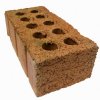For years, I used to take my dull kitchen knives to a little man at our local street market, but he got older and older and finally vanished. So I decided to do it myself. I was inspired by a jig that a friend of mine got for sharpening his pocket knife. It's made by a company named DMT:

I bought three diamond-loaded water-lubricated hones, and rummaged around my tiny shop for various bits and pieces of metal and wood. Here is the result:

It looks like this when bolted to my workbench, with a blade clamped into a modified door hinge, and with the movable supports on either side screwed down:

The hone, with its orange handle, is constrained to encounter the blade at a fixed angle that is set by the adjustable height of the horizontal wooden bar:


The table tells me how to adjust the bar vertically, depending on the width of the blade and the desired sharpening angle (can't believe that high school trigonometry is actually good for something!).
This jig works really well. I was improvising as I made it, and would probably design it differently now that it's finished - but that is standard for this kind of DIY exercise.

I bought three diamond-loaded water-lubricated hones, and rummaged around my tiny shop for various bits and pieces of metal and wood. Here is the result:

It looks like this when bolted to my workbench, with a blade clamped into a modified door hinge, and with the movable supports on either side screwed down:

The hone, with its orange handle, is constrained to encounter the blade at a fixed angle that is set by the adjustable height of the horizontal wooden bar:


The table tells me how to adjust the bar vertically, depending on the width of the blade and the desired sharpening angle (can't believe that high school trigonometry is actually good for something!).
This jig works really well. I was improvising as I made it, and would probably design it differently now that it's finished - but that is standard for this kind of DIY exercise.


